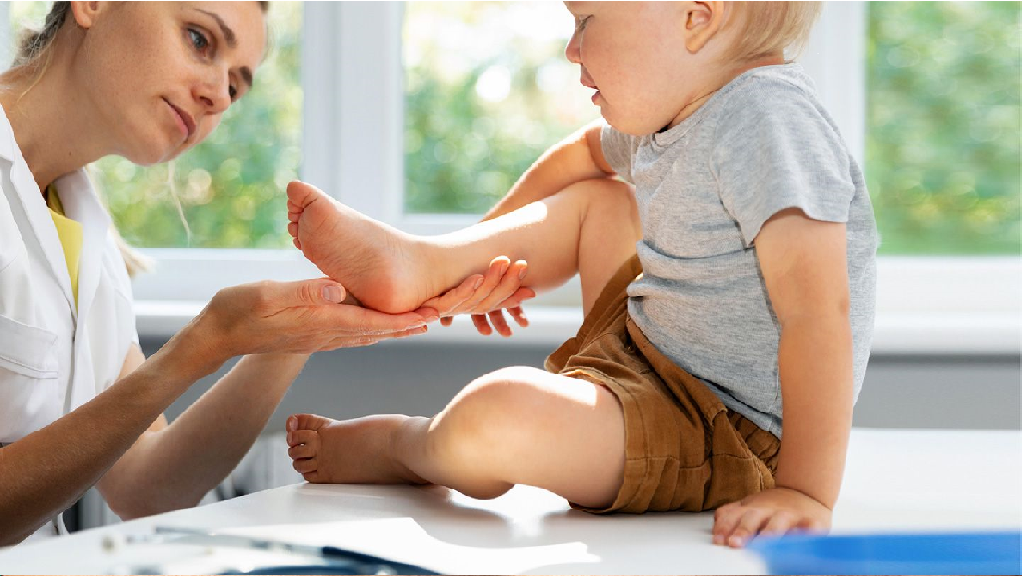
What is juvenile idiopathic arthritis?
Juvenile idiopathic arthritis (JIA) is a type of autoimmune inflammatory arthritis that can be seen in children under the age of 16 years. Autoimmune diseases generally occur when the body's immune system begins to malfunction and attacks healthy tissue in various parts of the body, causing inflammation and damage. In JIA, joints can become stiff, painful, and swollen. In some severe subtypes of JIA, organs such as the eyes, heart, lungs or skin can be involved.
The main symptoms of juvenile idiopathic arthritis
The most common complaints of children at the time they develop JIA are joint pain, joint swelling or joint stiffness. Other warning signs that may be present at the onset of disease include:
- Change in ability to keep up with normal activities, such as participate in sports or school because of physical joint pain
- Irritability, especially in young children in pain
- Refusal to walk, noticeably limping, or in young toddlers, a return to crawling
There are seven subtypes of JIA, defined by the International League of Associations for Rheumatology (ILAR) international criteria: oligoarticular, extended oligoarticular, polyarticular, enthesitis-related arthritis, psoriatic arthritis, and systemic onset. Learn more about the diagnosis of each of these here.
Treatment for juvenile idiopathic arthritis
While there is no cure for JIA, treatment advances are allowing more children to live normal lives. Medications have been developed that can reduce pain and even slow or stop the inflammation that causes devastating joint damage. As well, physical and occupational therapy can help to allow children to participate in normal activities, and to prevent long-term disability.
Medication
There are a number of medications commonly used to treat JIA. Some manage the symptoms, and others treat the underlying disease process.
- Treatments that help manage symptoms include non-steroidal anti-inflammatory drugs (NSAIDs). Naproxen (Naprosyn®) is the most common NSAID used for treating JIA, but others are used as well.
- Treatments that target the underlying problem include disease-modifying anti-rheumatic drugs (DMARDs). Examples of these include hydroxychloroquine (Plaquenil®), sulfasalazine (Azulfadine®), leflunomide (Arava®) and most commonly methotrexate (Rheumatrex®). DMARDs work to slow or halt the inflammation and disease progression that can cause devastating joint damage and disability. Many children have an excellent response to one, or a combination, of these medications.
- For some children, traditional DMARDs alone will not be enough to control their disease. In these cases, a biologic response modifier may be used. Biologics are the newest, most powerful medications to treat inflammatory arthritis. Examples of these medications are etanercept (Enbrel®) and infliximab (Remicade®). Newer biologic medications are currently being studied in children with JIA. Biologics are often used in combination with traditional DMARDs.
Many parents/guardians of children with JIA note that giving medications is one of the most difficult parts of coping with the disease. Education is such a critical part of a treatment plan for JIA. Like many inflammatory conditions, early aggressive treatment is vital. Caretakers who are well informed are more likely to be able to help create and implement a well-rounded, effective treatment plan. It is important to remember that children who are treated quickly and effectively have the very best chance of recovering fully and maintaining joint health. The pediatric rheumatology team, especially the nurse, is usually a great support for parents as they learn to support their child.
Physiotherapy and occupational therapy
Physiotherapy and occupational therapy are very important treatment plan components for every child with JIA. The physiotherapist and occupational therapist will work on regaining range of motion in stiff joints, providing techniques for pain relief, splinting when required, and once the disease is controlled, an exercise plan. Further, physiotherapist and occupational therapist can help to adapt everyday activities to be more accessible for children living with JIA.
Exercise
Exercise and play are key component of a well-rounded treatment plan for JIA and should be skillfully balanced with adequate rest. Exercise can help maintain joint health — keeping them mobile— and rest can help with recovery and adaptation. Children with JIA are encouraged to participate in usual activities, such as physical education and team sports at school, to the best of their abilities. If symptoms are well controlled, very little is off limits. However, movements that involve certain joints with arthritis can make them less suitable. For example, basketball may be uncomfortable with active arthritis in the knees or ankles. Finding the right fit might take some time and that is okay. Start with low impact activities that challenge the cardiovascular system including swimming and cycling. Remember children with JIA are outstanding athletes, they simply require patience and encouragement like anyone else.
Nutrition
The importance of a nutrient rich diet is well recognized in children with JIA to support physical and mental growth. It is thought that whole foods help the body recover and reduce inflammation in JIA patients. Thus, a balanced meal includes a good balance of complex carbohydrates, fruits, vegetables, and healthy fats. Inflammatory foods that contain artificial ingredients and excess amounts of sugar should be minimized to avoid the risk of additional health problems.